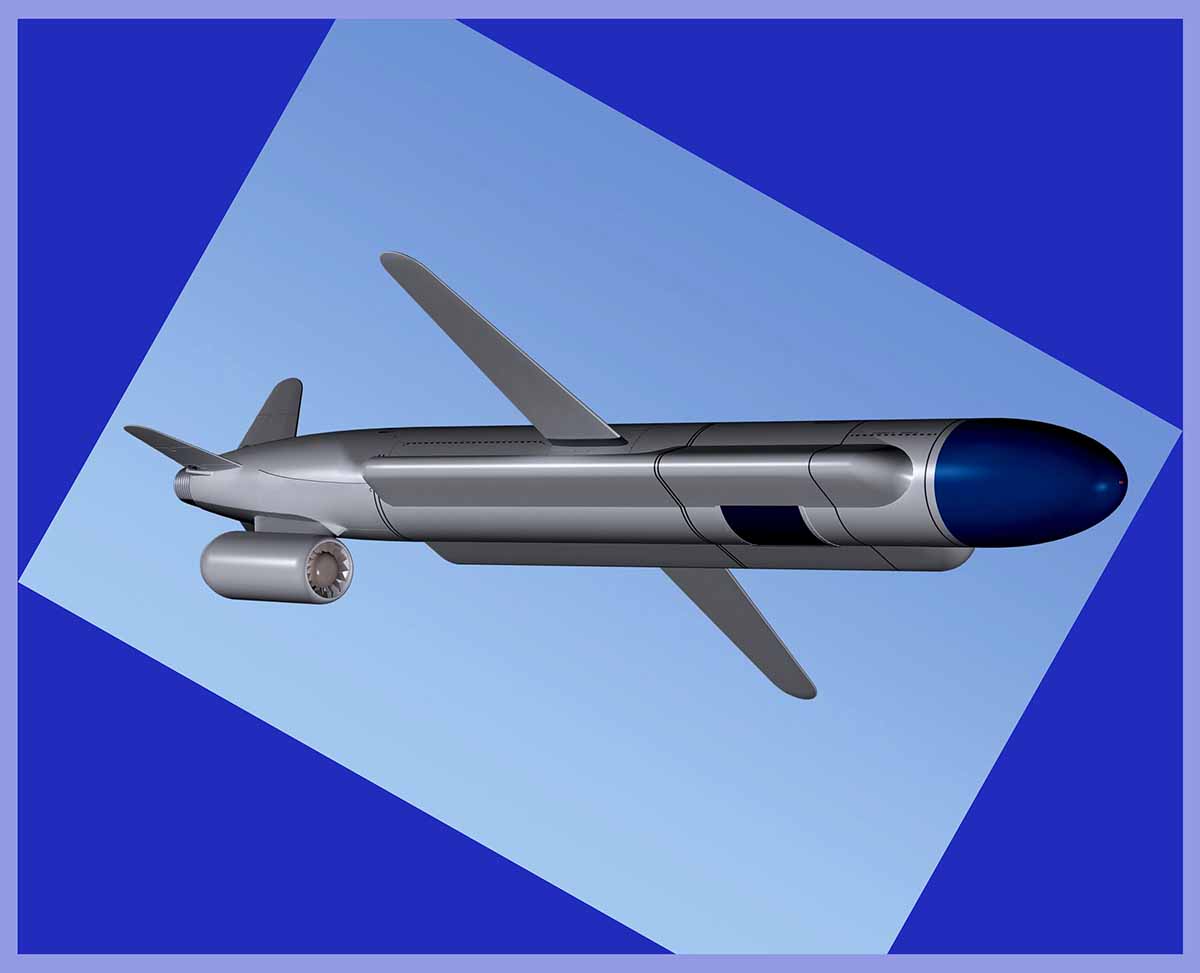Developed during the Cold War era and remains a crucial component of Russia’s strategic arsenal to the present day, we Unveil The Best Of The Russian Kh-55 Kent ALCM (Air-Launched Cruise Missile), designed by MKB Raduga in the 1970s. This missile measures approximately 6.4 meters in length and boasts a wingspan of 3 meters. The Kh-55 is propelled by a turbofan engine, allowing it to attain subsonic speeds and achieve extended ranges of up to 3,000 kilometres. It is exclusively designed for launch from bomber aircraft and has given rise to several conventionally armed variants, primarily for tactical use. Notably, variants like the Kh-101 and Kh-555 appear to be in active service as of now.

One of its notable features is its ability to carry both conventional and nuclear warheads, providing a versatile strike capability. The missile is equipped with advanced guidance systems, including inertial navigation and terrain-following radar, enabling it to navigate with precision over varying terrains. It can fly at low altitudes to evade enemy radar and air defences. The Kh-55 has a drop-down turbofan engine that enhances its survivability.
The Kh-55 Kent has been modernized and improved over the years, remaining a potent weapon in Russia’s strategic deterrence and long-range strike capabilities. Its range, accuracy, and payload options make it a formidable force on the modern battlefield.
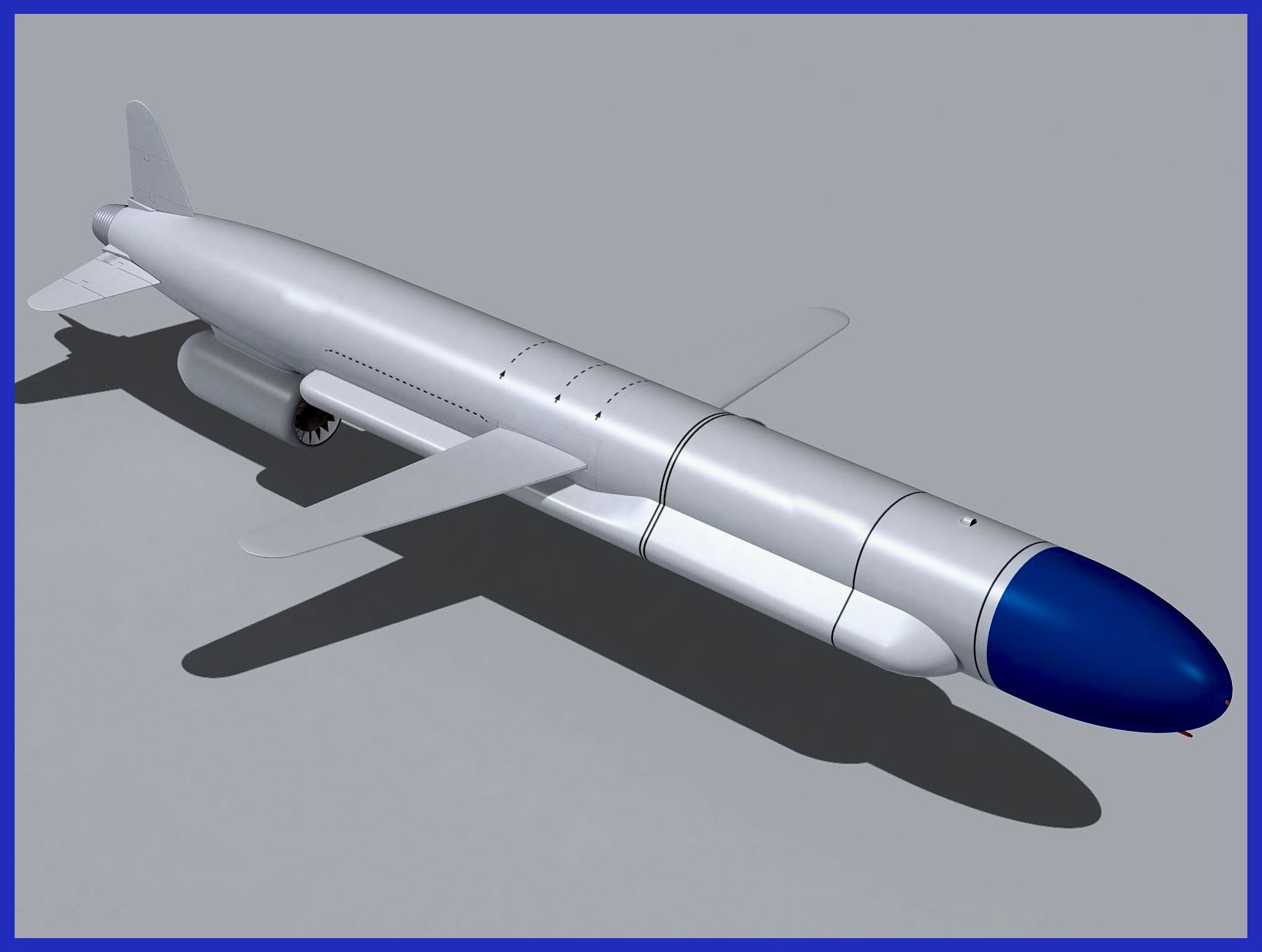
The Development Story of the Russian Kh-55 Kent ALCM
The Kh-55 Kent is a long-range air-launched cruise missile (ALCM) developed by the Soviet Union and later adopted by Russia. Its development story is characterized by secrecy and a focus on creating a highly capable and reliable weapon system.
Origins and Requirements
The development of the Kh-55 began in the late 1970s, amidst the backdrop of the Cold War. The Soviet military embarked on a quest to replace the ageing Kh-22 missile with a cutting-edge strategic cruise missile. This new missile was envisioned to possess an extended operational range, unparalleled accuracy, and the capacity to carry a nuclear warhead.
In the late 1960s, the GosNIIAS institute conducted the “Ekho” study, culminating in the conclusion that deploying numerous small, subsonic cruise missiles would be a more cost-effective strategy than the prevailing use of expensive supersonic missiles. This groundbreaking concept laid the foundation for the subsequent developments.
The Raduga bureau commenced its efforts on an air-launched cruise missile in 1971, culminating in a successful inaugural test flight in 1976. During the same period, the introduction of the US Air Force’s AGM-86 ALCM intensified competition in this domain. This, in turn, prompted the Soviet Air Force to establish a formal requirement for a new air-launched cruise missile in December 1976, which played a pivotal role in advancing the Kh-55 development program.
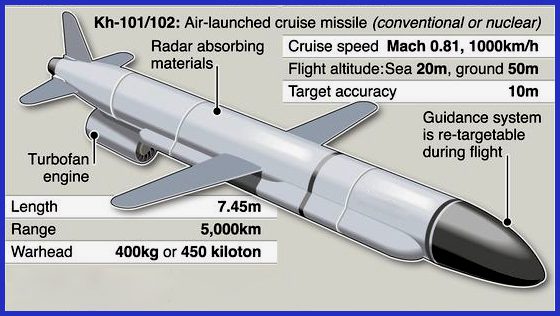
Design and Development
The Kh-55 was the brainchild of the Raduga Design Bureau, which is now part of the Tactical Missiles Corporation. This project was developed under the guidance of Chief Designer Igor Seleznyev from Raduga. Interestingly, a longer-range version, the Kh-55SM, was also developed a few years after the original entered service. In the late 1980s, efforts were initiated to replace the Kh-55 missile with options like the conventional Kh-101 or nuclear Kh-102 warheads, both equipped with enhanced stealthy characteristics.
The significance of advanced missiles as “force multipliers” grew as Russia’s inventory of cruise missile bombers declined in the early 1990s. The maiden flight of the Kh-101 took place in 1998, followed by comprehensive evaluation trials that commenced in early 2000.
Following the conclusion of the Cold War and the implementation of anti-proliferation treaties that imposed restrictions on the deployment of long-range nuclear missiles, the Russians redirected their efforts towards the development of tactical versions of the Kh-55, featuring conventional warheads. This shift in focus resulted in the creation of several new missile systems.
First in line was the Kh-65SE, boasting a range of 600 kilometres and derived from the Kh-55. It was officially unveiled in 1992. Subsequently, the Kh-SD, a tactical version of the Kh-101 designed for export with a range of 300 kilometres, was introduced. Lastly, the Kh-555 joined this lineup. In 2001, the Russian Air Force made the strategic decision to prioritize the further development of the Kh-101 and Kh-555 missile systems.

Stealthiness and Precision
The new generation Kh-101 and its subsequent versions were meticulously designed with several features to enhance their accuracy and make them highly resistant to interception. These missiles employed a turbofan engine for propulsion, enabling them to fly at low altitudes, effectively evading radar detection. Additionally, they were equipped with an inertial navigation system and terrain-following radar, which played a crucial role in precise navigation and in maintaining a low flight profile.

Upgraded Variants and Performance
The Kh-55 has undergone various iterations and enhancements over the years. The initial variant, known as the Kh-55SM/65SE, was deployed in the early 1980s. Subsequent versions included the KH-101/102/555, which featured upgrades to its guidance system and significantly improved accuracy, along with an extended range. These versions incorporated a low radar cross-section, approximately 0.01 square meters. The Kh-101/102 was specifically designed for air launch, departing from the circular fuselage cross-section of the Kh-55 in favour of a nose and forward fuselage section aerodynamically shaped to generate lift.
The Kh-101/102 missile has a length of 24.4 feet and a launch weight that falls within the range of 2,200 to 2,400 kg (equivalent to 4,900 to 5,300 lb). It can be equipped with either a 400 kg (880 lb) high-explosive, penetrating, or cluster warhead, or a 250 kt nuclear warhead. The missile’s propulsion system relies on a TRDD-50A turbojet engine, generating 450 kg of thrust. This allows it to maintain cruising speeds between 700 and 720 km/h (equivalent to Mach 0.57 – Mach 0.59), with a maximum speed of 970 km/h (equivalent to Mach 0.79), while flying at altitudes ranging from 30 to 70 meters above the ground.

Moreover, the Kh-101/102 possesses the capability to accurately target fixed locations, thanks to its use of a pre-downloaded digital map for terrain following and its reliance on the GLONASS/INS system for trajectory correction, achieving a remarkable accuracy of 6 to 10 meters.
Additionally, it is asserted that this missile possesses the capability to strike small moving targets like vehicles by employing a terminal electro-optical sensor or imaging infrared system. The estimated range of the missile varies, with some estimates suggesting a range of 2,000 km, while others propose a range between 4,500 to 5,500 km, with a flight endurance of approximately 10 hours. It’s noteworthy that the missiles are equipped with an onboard electronic warfare (EW) defence system, as per information available as of late 2018.
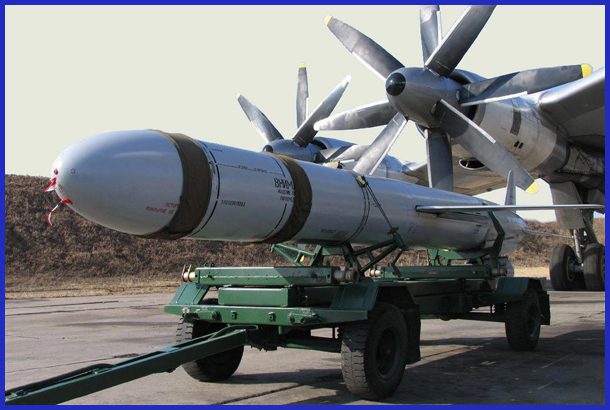
Deployment of the Kh-55 Missile System
The Kh-55 ALCM finds deployment on various Russian strategic bombers, including the Tu-95 Bear, Tu-22M3, and Tu-160 Blackjack. Furthermore, it has been adapted for use on surface ships and submarines, enhancing its versatility as a strategic weapon. The Tu-95MS has the capacity to carry eight of these missiles, with four mounted on under-wing pylons and four housed internally. In contrast, the Tu-160 is equipped with two drum launchers, each capable of holding six missiles. On the other hand, the medium-sized Tu-22M3 aircraft can carry either 2 or 4 Kh-55 missiles, and it also has the capability to deliver Kh-101/Kh-102 missiles. Additionally, the Su-34 aircraft can accommodate two Kh-65S/SE/SD missiles.
The combination of long-range ALCMs and bombers is vital for Russia due to its limited number of overseas bases, which makes it challenging to provide distant fighter escorts. The Kh-101/102 missile was officially accepted into service in 2012. At that time, the estimated cost of each missile was approximately US$13 million.

Export and Proliferation
In the post-Cold War era, there were concerns about Russia exporting the Kh-55 missile to several countries, which raised apprehensions regarding the proliferation of advanced cruise missile technology. In 1995, Russian documents indicated the transfer of a complete production facility to Shanghai, ostensibly for the development of a nuclear-armed cruise missile. Initially, it was believed to be based on the 300 km-range Raduga Kh-15 (AS-16 “Kickback”).
However, it later became apparent that the Kh-55 missile had been transferred, with the People’s Republic of China acquiring six from Ukraine and Iran acquiring twelve from Ukraine. These exports led to the missile being reverse-engineered and subsequently utilized by China in substantial quantities in the current context, which is also a matter of concern for India.

Strategic Role at Present
The Kh-55 and its various iterations have played a substantial role in bolstering Russia’s strategic deterrence capabilities. These missiles possess the dual capability of carrying both nuclear and conventional warheads, enabling them to effectively engage targets at extensive distances while maintaining high precision. Estimates of their range vary, ranging from 2,000 km (1,200 miles) to 4,500–5,500 km (2,800–3,400 miles), with a flight endurance of approximately 10 hours.
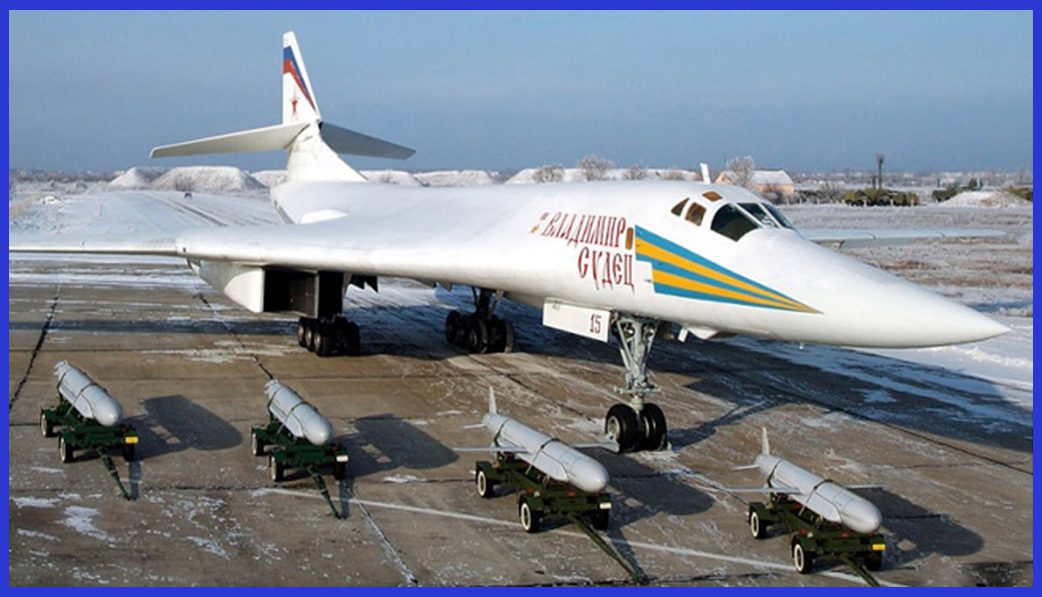
Design Analysis of the Kh-55 Kent ALCM
- Air-Launched Configuration: The Kh-55 missile can be launched from both high and low altitudes, maintaining subsonic speeds at low levels (below 110 meters/300 feet altitude). Its design is specifically tailored for low-altitude flight, often below radar coverage. This terrain-hugging flight profile significantly improves its chances of survival by reducing the likelihood of early detection and interception. Following the launch, the missile’s wings, tail surfaces, and engine deploy. Its air-launched nature offers flexibility in target selection and engagement, along with the capability to launch the missile from standoff distances.
- Guidance and Navigation: The Kh-55 missile utilizes a guidance system that combines both an inertial guidance system and a terrain contour-matching guidance system. This advanced guidance mechanism relies on radar and stored images within an onboard computer’s memory to identify and navigate towards its designated target. This dual guidance system grants the missile the capability to autonomously guide itself to the target with an exceptional level of precision. Furthermore, the missile features a terrain-following radar system that continually scans the terrain beneath it. This radar system makes real-time adjustments to the missile’s altitude and course, allowing it to smoothly follow the natural contours of the terrain. This particular capability enhances the missile’s stealthiness and guarantees precise flight.
- Turbofan Engine: The original Kh-55 featured a drop-down engine, whereas the Kh-65SE had a fixed external turbojet engine, and the Kh-SD housed its engine inside the missile’s body. By 2013, production versions of these missiles were equipped with an upgraded 450 kgf Russian-made NPO Saturn TRDD-50A engine. This enhancement enables the missile to maintain a steady speed and altitude throughout its flight, significantly increasing its difficulty to detect and intercept.
- Partial Stealth Features: Though not classified as a modern stealth missile, the Kh-55 is engineered with features aimed at minimizing its radar cross-section and infrared signature. These efforts include its low-level flight capability and the utilization of a turbofan engine, both of which contribute to diminishing its detectability.
- Payload Options: The Kh-55 can be equipped with various types of warheads, including nuclear and conventional options. This flexibility allows it to serve both strategic and tactical roles, depending on the mission requirements.
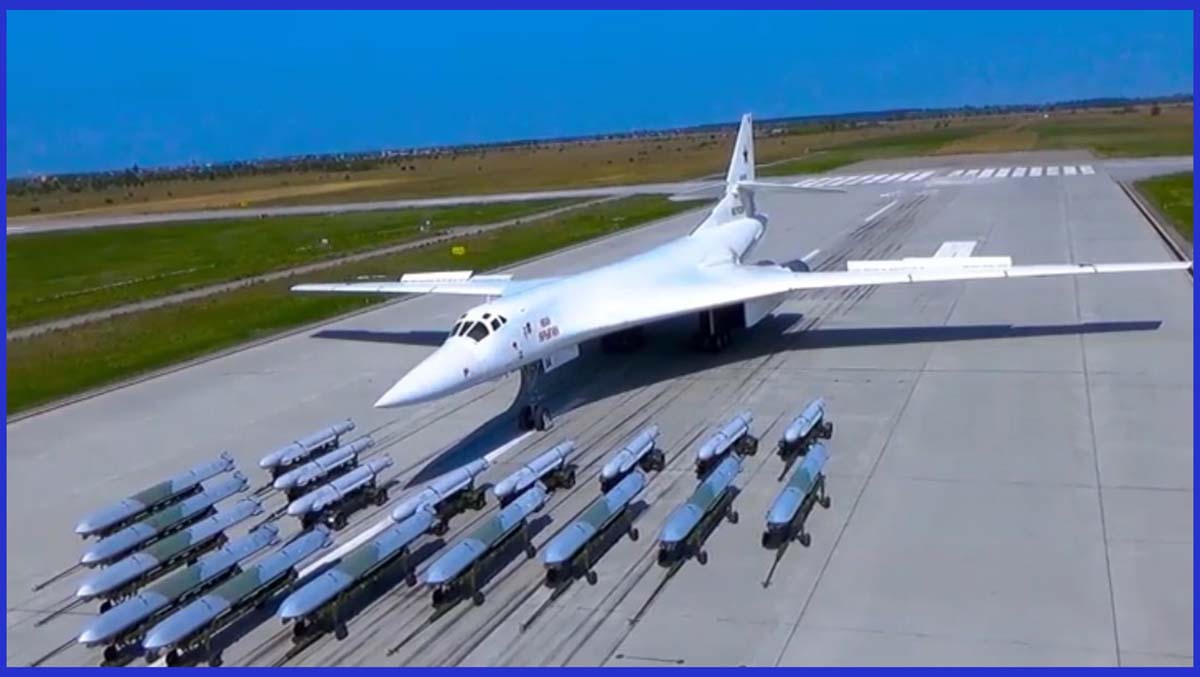
Tracing the Journey: The Significant Operational History of the Russian Kh-55 Kent ALCM
Combat Usage: Syrian Civil War
The Russian Ministry of Defence said in 2015, during Russia’s military engagement in the Syrian Civil War, that 34 air-launched cruise missiles were fired against 14 ISIL sites in Syria as part of a combined operation combining Tupolev Tu-95MS and Tupolev Tu-160 strategic bombers. Kh-55 cruise missiles were used by the Tu-95MS bombers, while the stealthy Kh-101 derivative made its first combat deployment on the Tu-160 aircraft.
In 2016, a modernized Tu-95MS aircraft, equipped with Kh-555 and Kh-101 air-launched cruise missiles, conducted airstrikes on suspected terrorist targets in Syria. This marked one of the few documented instances of the missile’s use in an actual combat scenario. In 2017, Kh-101 cruise missiles were launched from Tu-95MS strategic bombers, flying from Russian territory through Iranian and Iraqi airspace to strike purported ISIL targets near the Syrian city of Raqqa. These targets encompassed a command centre for a sizable ISIL unit, along with alleged insurgent camps and training facilities.

2022 Russian Invasion of Ukraine
In 2022, an estimated eight Kh-101 cruise missiles were launched from Tu-160 and Tu-95MS strategic bombers over the Black Sea, with the Havryshivka Vinnytsia International Airport as their designated target. The Ukrainian Ministry of Defense made a statement confirming that Russian forces utilized these eight Kh-101 cruise missiles, most likely launched from Tu-95MS bombers, to strike several hydraulic structures in Kryvyi Rih. This action resulted in a significant increase in the water level of the Inhulets River. Prior to this incident, there had been earlier reports suggesting the use of Kh-22 missiles.

Variants of the Kh-55 Kent ALCM
The Kh-55 has several variants, each with specific features and capabilities designed to meet various mission requirements.
- Kh-55 (Kent-A): This is the original and earliest variant of the Kh-55, It was first introduced in the early 1980s. The Kh-55 has a range of approximately 2,500 kilometres (about 1,550 miles) and is capable of carrying nuclear warheads.
- Kh-55-OK: with optical guidance addition
- Kh-55SM (Kent-B): This represents an enhanced iteration of the Kh-55, featuring improved guidance and navigation systems, as well as an extended range of 3,000 kilometres. It retains the capability to accommodate both nuclear and conventional warheads.
- Kh-65SE: This tactical version was officially announced in 1992, designed with a 410 kg conventional warhead and limited to a range of 600 kilometres. It was positioned in the market as a precision-strike weapon, intended for countries not pursuing nuclear capabilities.
- Kh-101/Kh-102: These are modernized versions of the Kh-55 missile, incorporating advanced stealth capabilities and enhanced guidance systems. They are specifically designed to carry conventional precision-guided warheads and boast a reported range of up to 5,500 kilometres (approximately 3,418 miles). The Kh-101 serves as the air-launched variant, while the Kh-102 is intended for submarine-based applications, featuring a thermonuclear warhead. It is anticipated that they will be available in the required quantities by 2023. This new missile complex has undergone successful testing and has been in recent years placed into series production to equip modernized Tu-160 and Tu-95MSM bombers.
- Kh-65SD: This variant, alternatively referred to as Kh-SD-5 represents a version of the Kh-55 missile tailored for export to nations interested in acquiring long-range standoff strike capabilities. In 1995, an iteration with a 300 km range and conventional warheads was introduced. Typically, it is configured with conventional warheads and is deployable from strategic bombers.
- Kh-555 (Kent-C): This variant is equipped with conventional warheads and features an enhanced guidance system and improved warhead technology. It achieved operational status in 2000 and was formally commissioned into service in 2004.
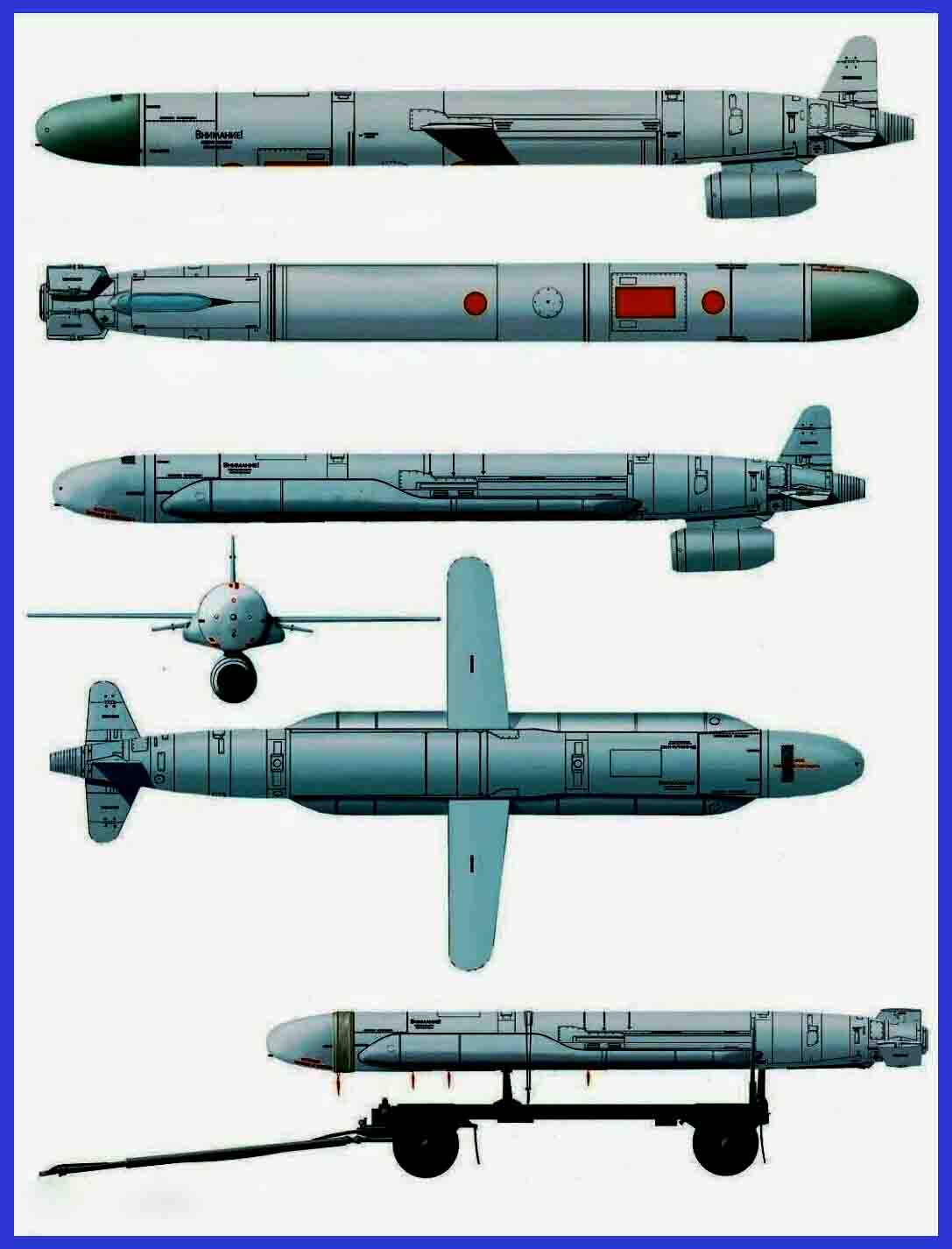
Technical Specifications of the Kh-55 Kent ALCM
- Weight: Kh-55: 1,650 kg (3,640 lb) / Kh-101: 2,400 kg (5,300 lb)
- Length: Kh-55: 19 ft 10 in ( 5.82 m ) / Kh-101: 24ft 5 in ( 7.33 m )
- Diameter: 20.2 in
- Wingspan: 122.0 in ( 3.09 m )
- Warhead: Thermonuclear or Conventional warhead
- Detonation: Proximity and impact fuses
- Blast Yield on Nuclear Warhead: 200 kt
- Engine: NPO Saturn TRDD-50A turbofan engine
- Propellant: Jet fuel
- Range: Kh-55: 2,500 km ( 1,300 nmi ) / Kh-55SM: 3,000 km ( 1,600 nmi ) / Kh-65SE: 600 km ( 320 nmi ) / Kh-101: 5,500 km ( 2,970 nmi )
- Speed: Subsonic ( Mach-0.75 )
- Minimum Flight altitude: 300 ft ( 110 m )
- Guidance: inertial guidance with Doppler radar/terrain map updates and active radar homing
- Launch Platform: Latest Russian strategic bombers, such as Tu-95MS, Tu-160, Tu-22M3, and Su-34
Apart from this missile article, seize this exclusive opportunity to acquire exquisite 1/72 premium die-cast models of the formidable MIG-25PD “Foxbat” on AirModels, with worldwide delivery. These iconic military jets, celebrated for their speed and track record, are available now. Don’t miss out on owning these meticulously crafted models that capture aviation history. Secure yours before stocks run out by clicking here.

In conclusion, the Kh-55 Kent ALCM represents a significant chapter in the history of air-launched cruise missiles. Developed during the Cold War era, it has evolved into a versatile and enduring weapon system that has played a crucial role in Russia’s strategic deterrence capabilities. With its long operational range, precision, and adaptability to both nuclear and conventional missions, the Kh-55 remains a formidable component of Russia’s arsenal.
Over the years, various variants and upgrades have been developed, extending the missile’s capabilities and adaptability to meet changing strategic needs. From the early Kh-55 Granat to the modern Kh-101 and Kh-102 variants with advanced stealth features, the Kh-55 family of missiles continues to exemplify the principles of reliability, accuracy, and versatility.
As international arms control efforts continue to address the proliferation of such missile systems, the Kh-55 Kent ALCM serves as a reminder of the enduring legacy of Cold War-era weaponry and the complex challenges associated with controlling and managing advanced missile technology in the modern era.
Important Announcement for Our Valued Readers!
After an article is published, it is possible that updates or changes may have occurred beyond the time of publication. Therefore, it is important to be aware that certain information in the article might be outdated. To ensure the most accurate analysis, it is highly recommended to verify the content with the latest sources available.
However, we are dedicated to delivering outstanding articles on military products and global updates. Maintaining quality and smooth operation requires resources. Your support sustains our efforts in providing insightful content. By purchasing high-quality products through our affiliated links, you help us keep our platform alive and acquire top-notch items. Your unwavering support is invaluable and inspires us to strive further.
We welcome your suggestions and requests for more information, as we value feedback from our readers. If there’s specific defence material or equipment not covered on our site, please share your request in the comments. We’ll strive to research and provide the required information. We sincerely thank you for your unwavering interest in our website, and we eagerly anticipate hearing from you! Enjoy your reading experience!
